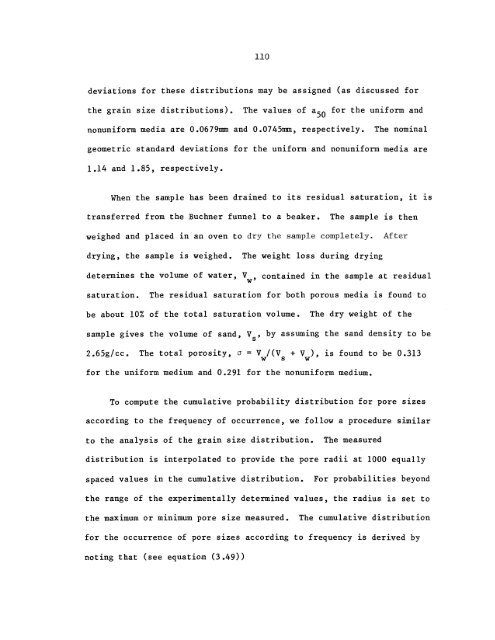longitudinal dispersion in nonuniform isotropic porous media
longitudinal dispersion in nonuniform isotropic porous media
longitudinal dispersion in nonuniform isotropic porous media
You also want an ePaper? Increase the reach of your titles
YUMPU automatically turns print PDFs into web optimized ePapers that Google loves.
110<br />
deviations for these distributions may be assigned (as discussed for<br />
the gra<strong>in</strong> size distributions). The values of a SO for the uniform and<br />
<strong>nonuniform</strong> <strong>media</strong> are 0.0679mm and 0.074Smm, respectively. The nom<strong>in</strong>al<br />
geometric standard deviations for the uniform and <strong>nonuniform</strong> <strong>media</strong> are<br />
1.14 and 1.8S, respectively.<br />
When the sample has been dra<strong>in</strong>ed to its residual saturation, it 1S<br />
transferred from the Buchner funnel to a beaker. The sample is then<br />
weighed and placed <strong>in</strong> an oven to dry the sample completely. After<br />
dry<strong>in</strong>g, the sample is weighed. The weight loss dur<strong>in</strong>g dry<strong>in</strong>g<br />
determ<strong>in</strong>es the volume of water, V , conta<strong>in</strong>ed <strong>in</strong> the sample at residual<br />
w<br />
saturation. The residual saturation for both <strong>porous</strong> <strong>media</strong> is found to<br />
be about 10% of the total saturation volume. The dry weight of the<br />
sample gives the volume of sand, V s ' by assum<strong>in</strong>g the sand density to be<br />
2.6Sg/cc. The total porosity, 0 = V I(v + V ), 1S found to be 0.313<br />
wsw<br />
for the uniform medium and 0.291 for the <strong>nonuniform</strong> medium.<br />
To compute the cumulative probability distribution for pore S1zes<br />
accord<strong>in</strong>g to the frequency of occurrence, we follow a procedure similar<br />
to the analysis of the gra<strong>in</strong> size distribution. The measured<br />
distribution is <strong>in</strong>terpolated to provide the pore radii at 1000 equally<br />
spaced values <strong>in</strong> the cumulative distribution. For probabilities beyond<br />
the range of the experimentally determ<strong>in</strong>ed values, the radius is set to<br />
the maximum or m<strong>in</strong>imum pore size measured. The cumulative distribution<br />
for the occurrence of pore sizes accord<strong>in</strong>g to frequency 1S derived by<br />
not<strong>in</strong>g that (see equation (3.49))

















